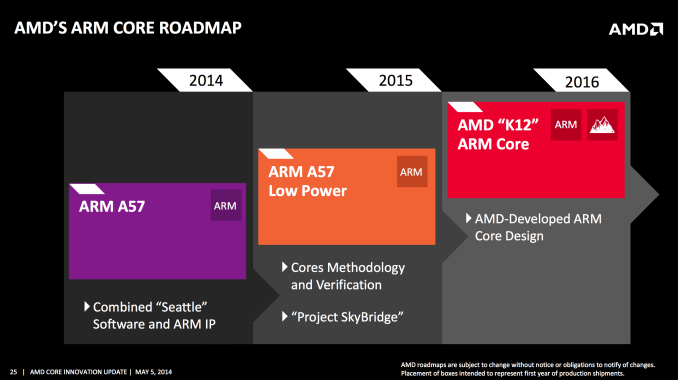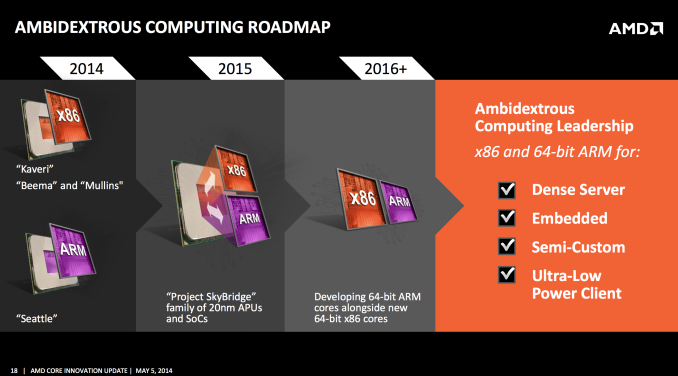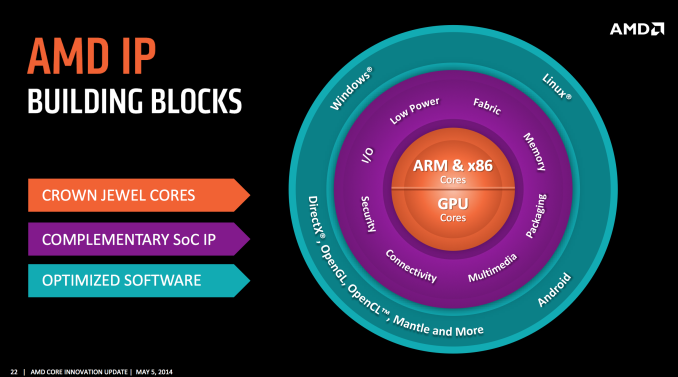AMD Announces K12 Core: Custom 64-bit ARM Design in 2016
by Anand Lal Shimpi on May 5, 2014 1:01 PM EST
In 2015 AMD will launch project SkyBridge, a pair of pin-compatible ARM and x86 based SoCs. Leveraging next generation Puma+ x86 cores or ARM's Cortex A57 cores, these SoCs form the foundation of the next phase in AMD's evolution where ARM and x86 are treated like equal class citizens. As I mentioned in today's post however, both of these designs really aim at the lower end of the performance segment. To address a higher performance market, AMD is doing what many ARM partners have done and is leveraging an ARM architecture license to design their own microarchitecture.
In 2016 AMD will release its first custom 64-bit ARMv8 CPU core, codenamed K12. Jim Keller is leading the team that is designing the K12, as well as a corresponding new 64-bit x86 design. AMD is pretty quiet about K12 details at this point given how far away it is. Given the timing I'm assuming we're talking about a 14/16nm FinFET SoC. On the slide above we see that AMD is not only targeting servers and embedded markets, but also ultra low power client devices for its 64-bit ARM designs (presumably notebooks, chromebooks, tablets). AMD has shied away from playing in the phone market directly, but it could conceivably play in that space with its semi-custom business (offering just a CPU/GPU core with other IP). Update: AMD added that server, embedded and semi-custom markets are obvious targets for K12.
There's also this discussion of modularity, treating both ARM and x86 cores as IP modules rather than discrete designs. AMD continues to have a lot of expertise in SoC design, all it really needs is a focus on improving single threaded performance. I can only hope (assume?) that K12 won't be Bulldozer-like and will hopefully prioritize single threaded performance. It's important to point out that there hasn't been a single reference to the Bulldozer family of CPU cores in any of these announcements either...
Update: Jim Keller added some details on K12. He referenced AMD's knowledge of doing high frequency designs as well as "extending the range" that ARM is in. Keller also mentioned he told his team to take the best of the big and little cores that AMD presently makes in putting together this design.












22 Comments
View All Comments
Alexvrb - Saturday, August 2, 2014 - link
Not really. Granted, we're going to see at least one more BD-derived design between now and then just to keep things moving. But the new x86 architecture is going to combine what they've learned with all the big core designs (including BD iterations all the way through Excavator) and what they've learned with their small core designs (such as Jaguar and Puma).Kim Keller has lead the design of some very successful architectures, so I am very interested to see what they cook up. Too bad we won't really see the results until ~2016.
Anders CT - Monday, May 5, 2014 - link
I had somewhat written of AMD. But their Beema/Mullins design looked to have potential, so maybe they can still surprise. Count me as mildly interested.And hedging their bets by doing some arm designs is propably prudent.
Tronyeu0802 - Monday, May 5, 2014 - link
Does this mean that they are making a super chip that can run both Andoid and Window? Or just 2 different cores on one die?mrdude - Monday, May 5, 2014 - link
The Project SkyBridge announcement was that there will be a single platform that's "pin compatible" between both ARM (A57s) and x86 (Puma+). Presumably this gives AMD the opportunity to reuse IP blocks between the two different chips while allowing OEMs to design a single tablet/device and utilizing either ARM or x86 depending on what they feel is more suitable (think a single tablet with ARM for Android but swapped for x86 for Windows but everything else remaining the same).K12 seems to be a custom ARM design, a la Apple and Qualcomm.
Gigaplex - Monday, May 5, 2014 - link
Two separate chips. You can buy either ARM or x86 for the same socket. And x86 already can run Android.Krysto - Monday, May 5, 2014 - link
ARM should just go fully ARM, and dump the x86 license (yes, I realize they can't quit x86 overnight, but they can deprecate it. Nvidia is on its way to do that anyway).testbug00 - Monday, May 5, 2014 - link
You mean "AMD should go fully ARM" I hope.Anyhow, based on the above correction being true, that is silly. As for NVidia on its way to get rid of x86... Nvidia never made x86 chips, and, if you mean Tegra... Well, Tegra is an abject failure from a fiscal standpoint.
jamescox - Tuesday, May 6, 2014 - link
High-end cpus are becoming increasing irrelevant in the consumer space. They are still needed in the workstation/server space, but how many consumer applications are actually cpu limited? As far as I can tell, most games are gpu limited, even at 1080p. I saw a review somewhere and you had to go back to a Core 2 Duo before performance dropped in any really significant way. I suspect that may be due to the age of the platform (DDR2 + PCIe 1.1) rather than the actual cpu core.If you look at CPU cores, they are tiny. Haswell is actually very large compared to low-power ARM cores and such. I think it is only around 14.5 square millimeters for a single core, and I believe that includes the 256KB L2 (hard to find data for individual core). It is definitely time for the cpu to move onto the gpu die. After the caches, the largest component is probably the FPU due to all of the vector extensions (MMX, SSE, etc). As far as I know, Intel is still planing on expanding the vector capabilities in the CPU. This makes little sense to me. If they can tie in the GPU units closely enough, then any vector code should just use the GPU. For the cpu, it seems like just a few low-latency, scalar fp units would be the way to go, and execute all of the vector operations on GPU units.
We are currently being held back by the form factor, although I have wondered if anyone will make a laptop (or something other than a console) with GDDR5 connected directly to an APU (would probably need to be soldered to board also). Many problems disappear once they can start stacking memory chips in the APU or GPU package. All that is needed for APUs to take over is really high speed interconnect to allow multiple APUs to work together. Nvidia is working on this with nvlink, although only for gpus; they still need an external cpu in the PC/workstation space. Intel is really working on the same technology as AMD, they are just at different points. Intel has a good CPU but not that great of GPU yet. AMD has sufficient CPU performance and good GPU tech. Intel still has the marketing position of having the best single thread performance, but this isn't anywhere near as important as it used to be. Enthusiast probably place too much importance on it.
For the server space, Intel tried to switch ISA with IA-64, which is now dead. They are stuck with x86, since they failed to make IA-64 fly, and they will not use ARM. The question is, for high-density servers, will x86 be able to match the performance per watt of ARM cores? AMD will be able to put a large number of ARM cores on a server chip, so if they are not too far behind in process tech, this could be a very good solution.
lordken - Sunday, April 5, 2015 - link
@jamescox : you are wrong with your core 2 of being good enough for games assumption. I still have E8400 and it is holding my HD7950 back a bit. There are games where my GPU is at ~50% while both CPU cores at 100% (and low fps so clearly cpu holding back the system)Also I dont think that putting RAM on APUs is good idea as that will end customability of chosing how much RAM you want to have in PC. You would be stick with just what is on APU.
As what i agree with you is, that probably CPU functionality should be moved to GPUs, as they seem to be able to provide much higher computation anyways. Thats actually what I was thinking is going to happen when amd came with APUs, to move GPU from discreet card to "cpu" socket with added cpu functionality.
Question only remains what to do with SLI/crossfire/scalability. Either to have motherboards with multiple sockets (something like servers) or just drop standard cpu socket and go away with current PCIe slots, allowing pretty nice scalability. You would just add another "GPU/APU" card if you need more power, something like with server blades.
ws3 - Tuesday, May 6, 2014 - link
So Apple released their first 64 bit custom ARM core in 2013 and AMD is going to do the same in 2016?That makes them 3 years late. Why should we expect them to produce a class leading device? Sure AMD has experience, but Apple and Qualcomm have a huge head start and proven CPU design teams of their own.